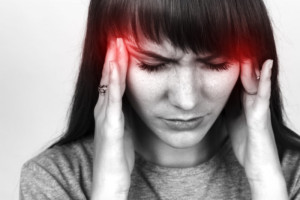 Migraines are a neurological condition that often involves headaches as a primary symptom. The truth is that migraines can happen with or without a headache and can involve a number of other possible symptoms such as the following:
Migraines are a neurological condition that often involves headaches as a primary symptom. The truth is that migraines can happen with or without a headache and can involve a number of other possible symptoms such as the following:
- Nausea and vomiting
- Pain on one side of the head, rarely both sides
- Dizziness
- Sensitivity to light, sound, and certain odors
Some symptoms may occur up to two days before the onset of the previously mentioned symptoms. These include the following:
- Food cravings
- Tiredness or low energy levels
- Repeated yawning
- Irritability
- Stiff neck muscles
- Hyperactivity
- Depression
- Aura: seeing shapes or flashing light, visual blind spots, losing your vision, problems with speech, or a tingling or pins and needles sensation in your face, legs, or arms
After the migraine has passed, there are some symptoms that may persist, such as a dull headache, moodiness, and extreme elation or exhaustion. Not only is every migraine different, but the experience for each individual is different as well.
Table of Contents
Who Is More Likely to Suffer from Migraines and How Long Does an Episode Last?
Women are three times more likely to have migraines than men are. Migraines not limited to any set age group, though they are more prominent in those between ages 15 and 55. Migraines appear to have a hereditary component because someone who has family members with migraines has a higher risk of developing them. Migraines affect a massive number of people, with statistics showing approximately 139 million men, women, and children in the United States alone and up to 1 billion worldwide.
The duration of a migraine is generally 4 hours but can last as long as 72 hours if not tended to.
To learn more about the connection between head and neck injuries and migraines, download our complimentary e-book by clicking the image below.
What Is the Relationship Between Migraines and Inflammation?
Inflammation is the body’s natural response to infection, disease, and injury as it does its job to contain, destroy, or dilute whatever is threatening the body. Indications of inflammation can be swelling, redness, or heat, which is why pain and inflammation are often paired together. This normally does not include migraines, since it is believed that migraine pain is associated with abnormal dilatation of the blood vessels in the brain, though it has not been proven.
However, there has been more and more recent research giving evidence that inflammation is a major contributor to migraine onset. Researchers have found that by taking an anti-inflammatory medication or opting for an anti-inflammatory diet, a person can reduce their migraines.
There is a newly developed medication that combines the migraine drug Imitrex, with the anti-inflammatory drug naproxen sodium (such as Aleve). The triptan (Imitrex) keeps blood vessels from dilating while the anti-inflammatory drug (Aleve) prevents the release of inflammation-triggering enzymes.
Another drug being tested is supposed to work by inhibiting a protein released during inflammation, called calcitonin gene-related peptide (CGRP). This protein has been seen to be higher than normal in migraine patients.
The hope of researchers is to develop a drug that does not include the side effects associated with anti-seizure or blood-pressure-lowering medications. These drugs are often unavailable to those with heart disease. This kind of research and progress could take many years before a product gets completed and approved.
Migraines, Lifestyle and Hormones
One of the primary reasons that women probably get migraines far more than men is due to the menstrual cycle and the drop in estrogen levels that occurs on a regular basis. In fact, menopause can be a welcome reprieve for many women who suffer from hormone-induced migraines.
Environment and lifestyle could also be a contributor to migraines. Below is a list of things that trigger migraines in some people:
- Weather changes
- Changes in altitude
- Barometric changes
- Bright, flashing lights
- Not getting enough rest
- Being overstressed
- Certain odors
- Food – aged cheeses, caffeine, MSG, nitrates, and aspartame to mention just a few
Identifying what triggers your migraines can be a bit of a process because triggers vary from person to person. After exposure to a trigger, the migraine may not occur for several hours or up to two days. Blood vessels in your forehead begin to swell, resulting in the nerve fibers releasing a chemical that leads to pain and inflammation. During this process, the blood vessels become even larger, increasing the pain. This chain-reaction goes on for a few hours until it reaches a threshold called central sensitization. This leads to the pain-nerve cells getting stuck in the on position so that the slightest movement can lead to pain, including the pulse of blood in your brain. If this impacts your intestinal system, you may feel nauseous or you may vomit or get diarrhea.
Getting Migraine Relief from a Natural Source
There is a possibility that the reason that inflammation could cause such a strong reaction as migraines has to do with a disruption in the signals being sent to the brain. A misalignment in the uppermost vertebrae of the spine could be the culprit. When these particular bones shift out of their proper position, it can cause this kind of communication interruption. To correct a subluxation of this kind, it is best to turn to the care of an upper cervical chiropractor who specializes in the gentle and precise adjusting of these unique vertebrae. Studies report positive results in as few as one or two adjustments with many patients seeing their migraines resolve entirely. We are happy to report that we have had similar results with our patients. If you are interested in obtaining similar results, we would love to meet with you and hear more about your specific condition.
To schedule a complimentary consultation with Dr. Hejny, call our Spring Lake Park office at 763-230-0116. You can also click the button below.
 If you are outside of the local area, you can find an Upper Cervical Doctor near you at www.uppercervicalawareness.com.
If you are outside of the local area, you can find an Upper Cervical Doctor near you at www.uppercervicalawareness.com.
